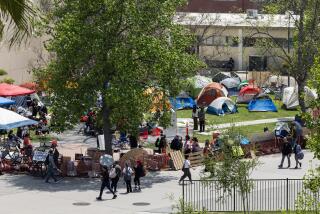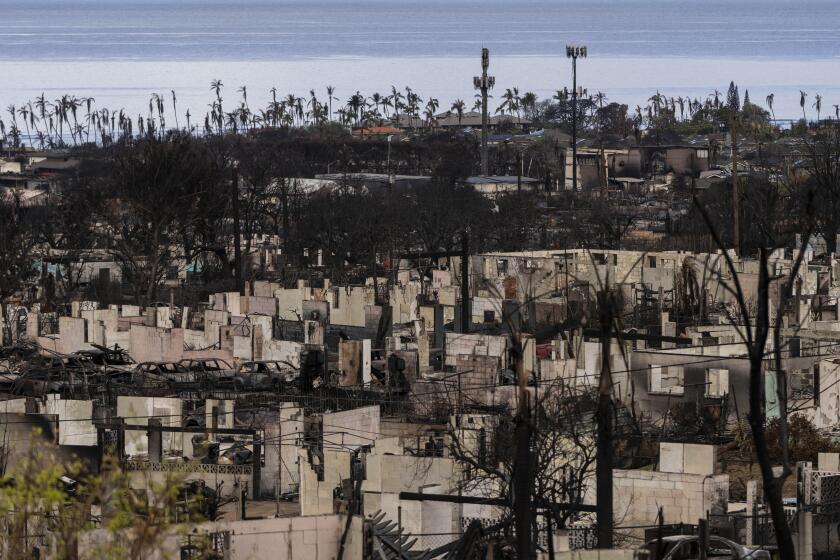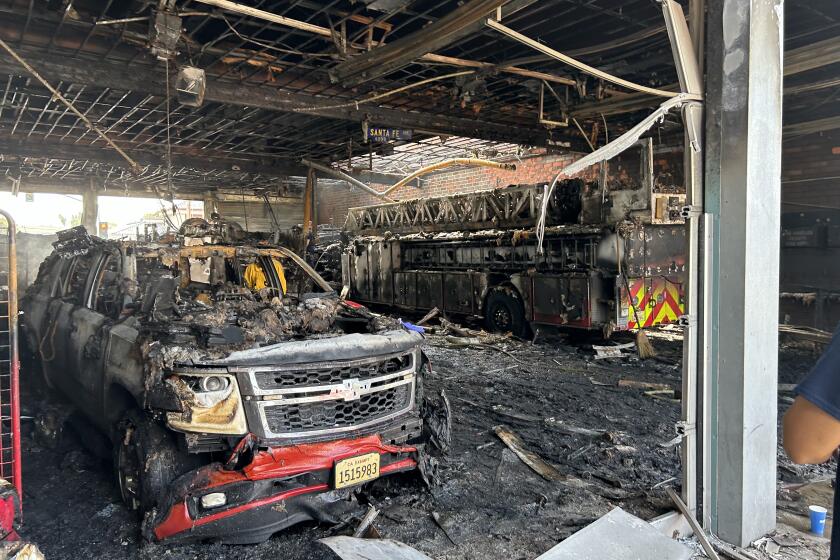Brush Fire : How to Protect Your Home This Season
Many houses in the San Fernando Valley area are dangerously close to brush-covered hillsides and savannas, and fire officials warn that the ingredients of a big fire could come together this summer.
The winter rains may have halted the drought, but they produced a bumper crop of tall grass that will turn to volatile fuel as it dries in the summer sun.
A combination of conditions increases the chances of a dangerous brush fire occurring: winds above 20 m.p.h., relative humidity below 30% and low moisture content, less than 6%, in the fuel. The sun is also a factor; a fire’s march usually slows when the sun goes down.
* Clear brush from area surrounding property. State law requires residents to keep flammable vegetation cleared for 30 feet away from structures.
* Trim or remove tree limbs near house and remove leaves from roof and gutters.
* Keep wood piles away from buildings.
* Cover chimney with half-inch steel mesh to prevent sparks from igniting roof or brush.
When Fire Hits Home
If a brush fire is approaching, you should be prepared to flee as well as fight. In both cases, preparation is the key, fire officials say.
Before Firefighters Arrive . . .
* Back car into garage for quick escape; close car windows.
* Have predetermined, practiced escape routes.
* Be prepared to open garage door manually if electricity goes out.
* Place valuables and documents, including videos and photo albums, in car.
* Have pets ready to go.
Defending Your House . . .
* Place non-combustible ladder against house for roof access.
* Attach 100-foot hose to spigot.
* Close doors and windows, seal attic and basement vents.
* Remove sheer window curtains, close heavy curtains.
* Store combustible materials, such as patio furniture, in garage.
* Fill large trash cans with water and place around house. Have sponges, small rugs or burlap sacks around to dip into water and extinguish spot flames.
* Turn off propane tanks.
* Leave lights on in house. Heavy smoke makes house dark.
* Wear long-sleeved shirts, pants, gloves, a dampened bandanna and goggles if available.
* Wet roof with garden hose only when fire comes to within 600 feet, then get down from roof.
Fire at Your Doorstep
* If the fire is moving swiftly, it may be safer to stay in your house rather than try to outrun it. The fire front may move so quickly that it could pass by the house. If the roof catches fire, get in your car, pull into driveway and turn on air conditioning. Stay put. That’s safer than driving through smoke and heat.
And After the Fire Passes . . .
* With a garden hose, barrels of water and damp rugs, extinguish small spot fires on roof and around house. Keep doors and windows closed. Maintain a four-hour vigil around house, checking that no embers have gotten into attic or under the eaves.
Famous Fires in Valley Area
* September, 1970. About 400 structures were destroyed and 10 people killed in several fires that roared as a single wall of flame from Newhall to Malibu.
* October, 1978. A series of fires destroyed 230 structures and burned about 33,000 acres from Malibu to Agoura to Mandeville Canyon.
* December, 1988. Twenty homes were destroyed and 50 damaged as 2,670 acres burned in Porter Ranch.
* June, 1990. An early summer fire raged through Glendale, destroying 46 houses and damaging 20 others.
Key to Survival:
Preparation
“There isn’t a staggering number of brush fires compared to other (fires), but the potential for destruction is incredibly great, given in this area the high value of real estate, the narrow streets, difficult access and incredible fuel load . . . Southern California has the fastest-burning, most volatile ground fuel of anywhere in the world. Pound for pound, it has the energy-generating capacity of gasoline.”
Battalion Chief Dean Cathey, community liaison officer for Los Angeles City Fire Department.
“People believe when a wildfire hits their homes, the Fire Department will be there to save them. It’s physically impossible because there may be 100 to 300 homes threatened at once, and it’s monetarily impossible to fund that many engines. It’s dependent on the homeowner to prepare his house prior to a fire hitting and then be in the position to prevent it from burning. Those with wood shingle roofs are at greatest risk. . . . Remember, homes should be designed, constructed and maintained to withstand a wildfire without a fire engine in your driveway.”
Capt. John P. Harris, Fire Camp 15, Tujunga, Los Angeles County Fire Department
Sources: Los Angeles City Fire Department, Los Angeles County Fire Department
More to Read
Start your day right
Sign up for Essential California for news, features and recommendations from the L.A. Times and beyond in your inbox six days a week.
You may occasionally receive promotional content from the Los Angeles Times.






